AI Research
50 NEW Artificial Intelligence Statistics (June 2025)
This is a list of up-to-date artificial intelligence stats for 2025.
From ChatGPT to autonomous vehicles, AI is one of the most exciting (and controversial) technology trends in the 21st century.
But how big is the AI space? And how quickly is it growing?
In this article, we’ll take a closer look at key AI statistics, along with growth projections for the future.
Want to Beat Your Competition?
Find out who’s linking to them and build a better backlink strategy.
Top AI Statistics (Editor’s Picks)
- The global AI market is valued at approximately $391 billion.
- The AI industry is projected to increase in value by around 5x over the next 5 years.
- The AI market is expanding at a CAGR of 35.9%.
- As of 2025, as many as 97 million people will work in the AI space.
- 83% of companies claim that AI is a top priority in their business plans.
- Netflix makes $1 billion annually from automated personalized recommendations.
- 48% of businesses use some form of AI to utilize big data effectively.
- 38% of medical providers use computers as part of their diagnosis.
Artificial Intelligence Market Size
The AI market is worth around $391 billion (GrandViewResearch)
As of the latest available data, the global AI market is worth almost $400 billion.
This is primarily thanks to increasing practical use cases of AI technology, from content creation to self-driving cars.
Want to Spy on Your Competition?
Explore competitors’ website traffic stats, discover growth points, and expand your market share.
The global AI market is expected to reach $1.81 trillion by 2030 (GrandViewResearch)
While the current AI market is sizeable, it’s set to grow by nearly 5x over the next few years.

During this forecast period, the AI market is predicted to increase by a CAGR of 35.9%.
The AI software market’s global annual revenue stands at over $100 billion (Omdia)

The AI software market’s global annual revenue (2018 to 2025):
| Year |
Revenue |
| 2018 |
$10.1 billion |
| 2019* |
$14.69 billion |
| 2020* |
$22.59 billion |
| 2021* |
$34.87 billion |
| 2022* |
$51.27 billion |
| 2023* |
$70.94 billion |
| 2024* |
$94.41 billion |
| 2025* |
$126 billion |
*Projected figures.
ChatGPT reached 1 million users in 5 days (OpenAI)
In late 2022, ChatGPT broke records as the AI platform reached 1 million users in less than a week.
By early 2023, ChatGPT had accumulated over 100 million monthly users.
And as of May 2025, OpenAI.com receives 1.2 billion monthly visits. ChatGPT.com receives over 5 billion visits, making it the #5 website globally.
Website visitors from AI search are 4.4x more valuable than visitors from organic search (Semrush)
And traffic from ChatGPT search is projected to overtake traffic from organic search in 2028.
To adjust to these emerging changes in search behavior, brands are moving to platforms such as Semrush Enterprise AIO to improve their visibility in AI search engines.

9 out of 10 organizations back AI to give them a competitive edge over rivals (MIT Sloan Management)
One survey found that 87% of global organizations believe that AI technologies will give them a competitive edge.
This equates to an increase of 12% from the previous year.
AI Adoption: Artificial Intelligence Growth
Between 2015 and 2019, the number of businesses utilizing AI services grew by 270% (Gartner, Forbes)
In 2015, just 10% of organizations used or planned to implement AI in the near future.
By 2019, this figure had surged to 37%.
Meanwhile, in the UK, the number of AI companies has increased by 600% over the past decade.
Approximately 1 in 3 organizations use AI (Hostinger)
According to Hostinger Tutorials, 35% of companies have turned to AI services to address labor shortages.
And 42% are considering AI adoption in the near future.
Global AI is growing at a CAGR of almost 40% (Grand View Research)
AI’s recent rapid growth is unlikely to slow down in the near future.
In fact, global AI adoption by organizations is set to expand at a CAGR of 35.9% between 2025 and 2030.
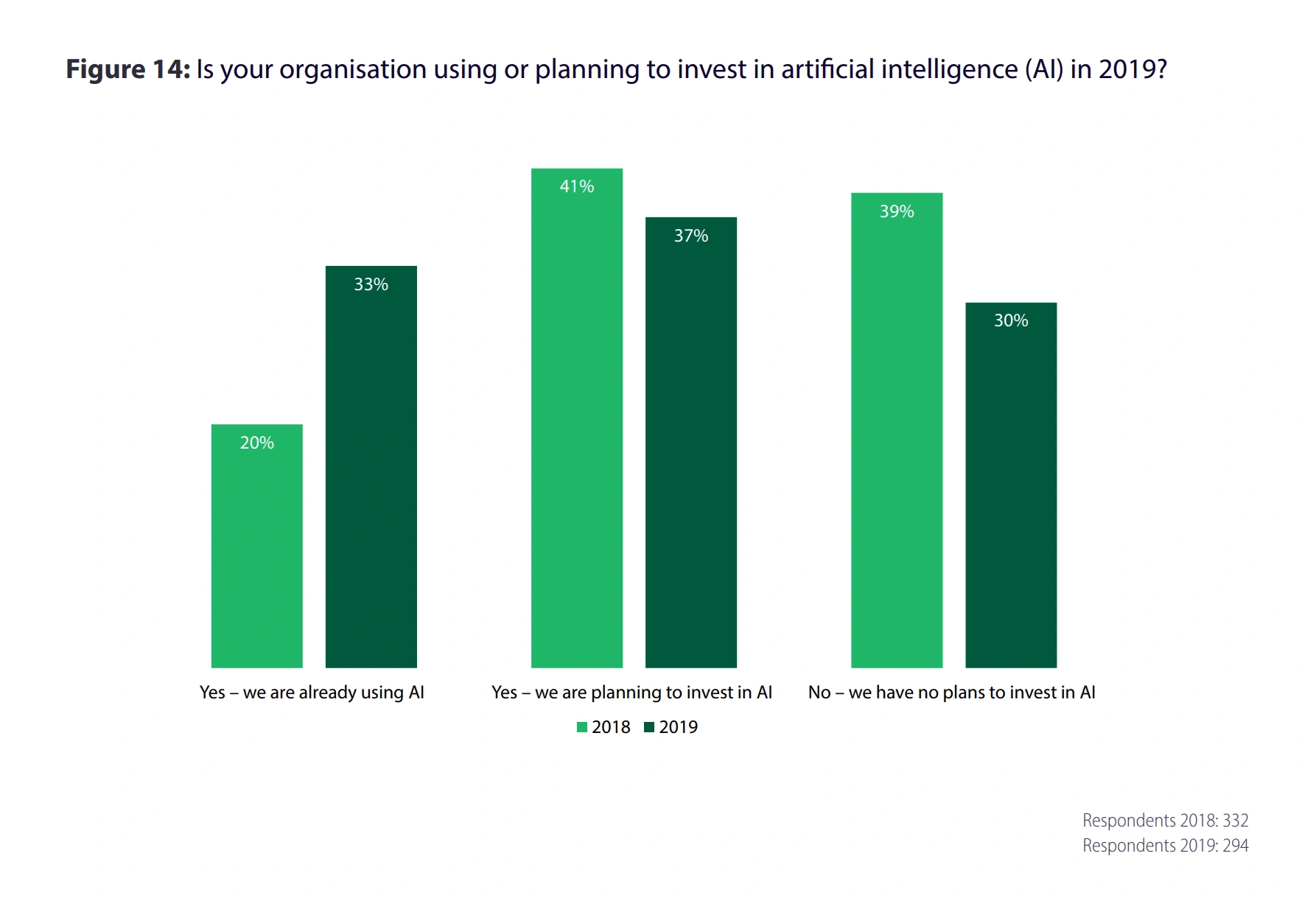
The wearable AI market is expected to reach $180 billion this year (Global Market Insights)
The success of products like the Apple Watch and Fitbits is set to boost the global wearable AI market value.
As of 2025, the market is set to reach $180 billion.
Instantly Analyze
Any Market
AI tech can increase revenue by over $15 trillion by the end of the decade (PwC)
Some estimates suggest that AI technology could generate $15.7 trillion in revenue by 2030. Boosting the GDP of local economies by an additional 26%.
The AI market is set to grow by 26% this year (Tractica)
The latest available data predicts a lucrative near future for the AI market.
Between 2021 and 2022, the AI market was projected to grow by 47%.
This upward trajectory was forecast to continue year-over-year, increasing by at least 26% each year:
| Year |
Year-Over-Year Growth |
| 2019 |
54% |
| 2020 |
54% |
| 2021 |
54% |
| 2022 |
47% |
| 2023 |
38% |
| 2024 |
33% |
| 2025 |
26% |
Worldwide AI chip revenue will surpass $80 billion in the next couple of years (The Insight Partners)
The latest data shows that global AI chip revenue is set to reach $83.25 billion by 2027.
Almost 100 million people are working in the AI space (Search Logistics)
If the projections about growth in the AI space come to fruition, further manpower will be required.
By the end of 2025, approximately 97 million people will be needed to fill the work demands of the surging industry.
Business analysts estimate that the US AI market is worth approximately $75 billion (Statista)
As dependency on human intelligence decreases, this figure is set to rise further.
As of 2025, the US AI space is worth a reported $73.98 billion. That’s a predicted CAGR of 26.95% between 2025 and 2031.
How Businesses Adopt Artificial Intelligence
Around 4 in 5 companies deem AI to be a top priority in their business strategy (Forbes)
A whopping 83% of companies claim that using AI in their business strategies is a top priority.
Automated emails and chatbots are two of the most common uses of AI in everyday business communications.

Here’s a look at current company usage of AI:
| AI Usage | Percentage |
| Don’t use AI currently, but are looking into it | 7% |
| Have tested a few proofs of concept with limited success | 14% |
| We have a few promising proofs of concept and are looking to scale | 21% |
| We have processes that are fully enabled by AI with widespread adoption | 25% |
| We have started implementing limited AI use cases. | 33% |
80% of retail executives expect their businesses to adopt AI automation by the end of 2025 (Analytics Insight)
The vast majority of surveyed retail executives in 2021 believed their company would utilize AI automation by next year.
Around 17 in 20 CEOs claimed AI would be “mainstream technology” in their company in 2021 (PWC)
86% of CEOs agree that AI and business go hand-in-hand since AI is mainstream technology in their offices.
AI is expected to improve employee productivity by 40% (PWC)
Data suggests that AI has the potential to boost employee productivity by approximately 40% by 2035.

Netflix’s recommendations technology is worth $1 billion in revenue annually (Business Insider)
Many consumers will likely agree that Netflix’s use of AI is one of its biggest selling points. The streaming platform utilizes AI to personalize recommendations and tailor them to viewers’ interests.
Tech companies that invest in AI often significantly increase their revenue, as algorithms can keep the consumer constantly returning for more.
Data shows that the top voice assistant by accuracy is Google Assistant (Loup Ventures)

Google Assistant outranks its voice assistant competitors, such as Apple’s Siri and Microsoft’s Cortana, with an accuracy record of 98% in navigation.
| Type of question | Google Assistant | Siri | Alexa |
| Local |
93% |
89% |
85% |
| Commerce |
92% |
68% |
71% |
| Navigation |
98% |
86% |
72% |
| Information |
96% |
76% |
93% |
| Command |
86% |
93% |
69% |
More than half of telecommunications organizations use chatbots (Gartner)
52% of telecommunications organizations utilize chatbots to increase their overall productivity.
Recent data indicates a substantial acceleration in the adoption of AI-powered applications (Gartner)
One key AI application in business is providing personalized product recommendations via consumer behavior forecasting and targeted advertising.
Pop-up marketing ads and chatbots are each examples of AI operations.
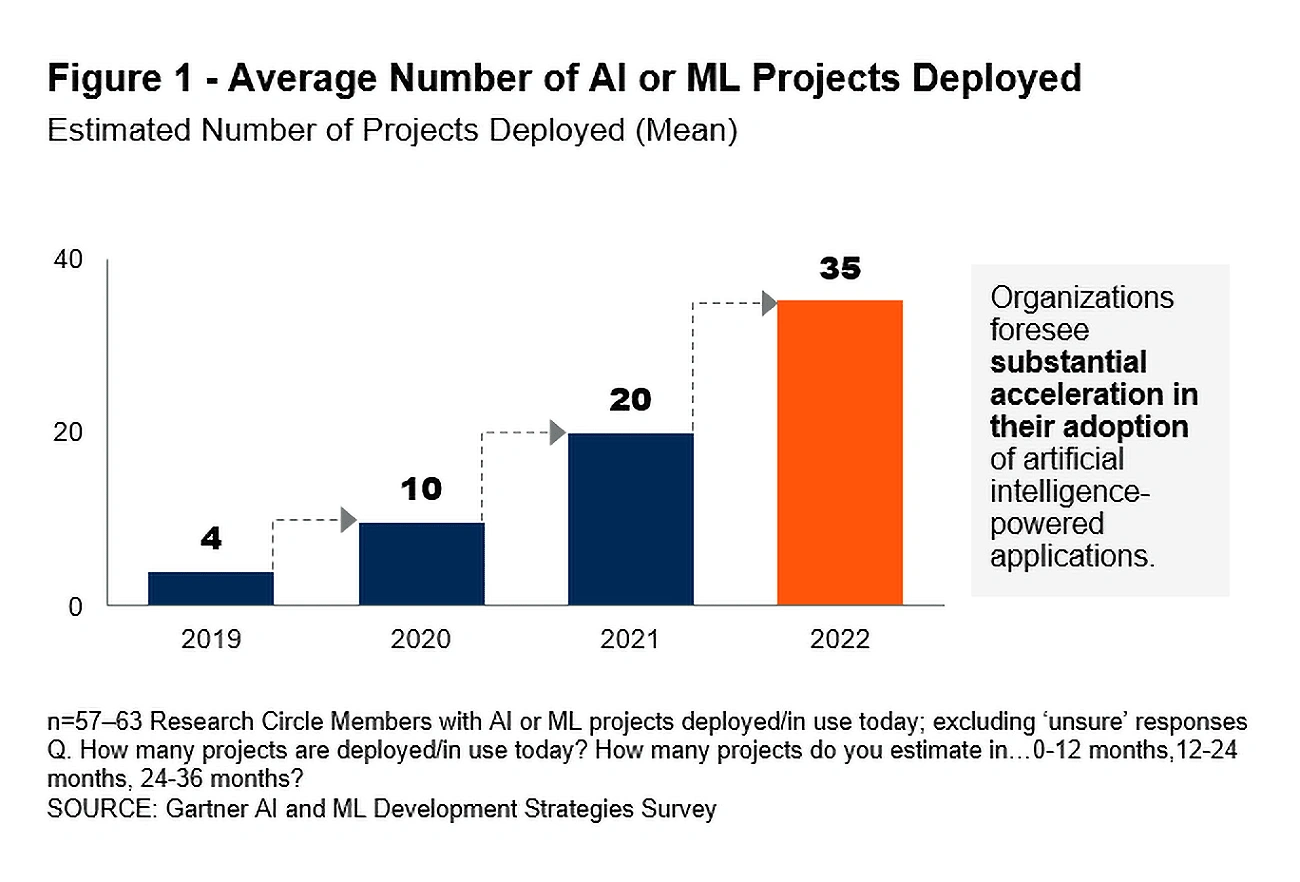
Automation usually translates to less waiting time for customers.
Nearly half of all businesses use some form of machine learning, data analysis, or AI (O’REILLY)
To maintain the accuracy of their data, 48% of businesses use machine learning (ML), data analysis, and AI tools.
The manufacturing industry stands to gain $3.78 trillion from AI by 2035 (Accenture)
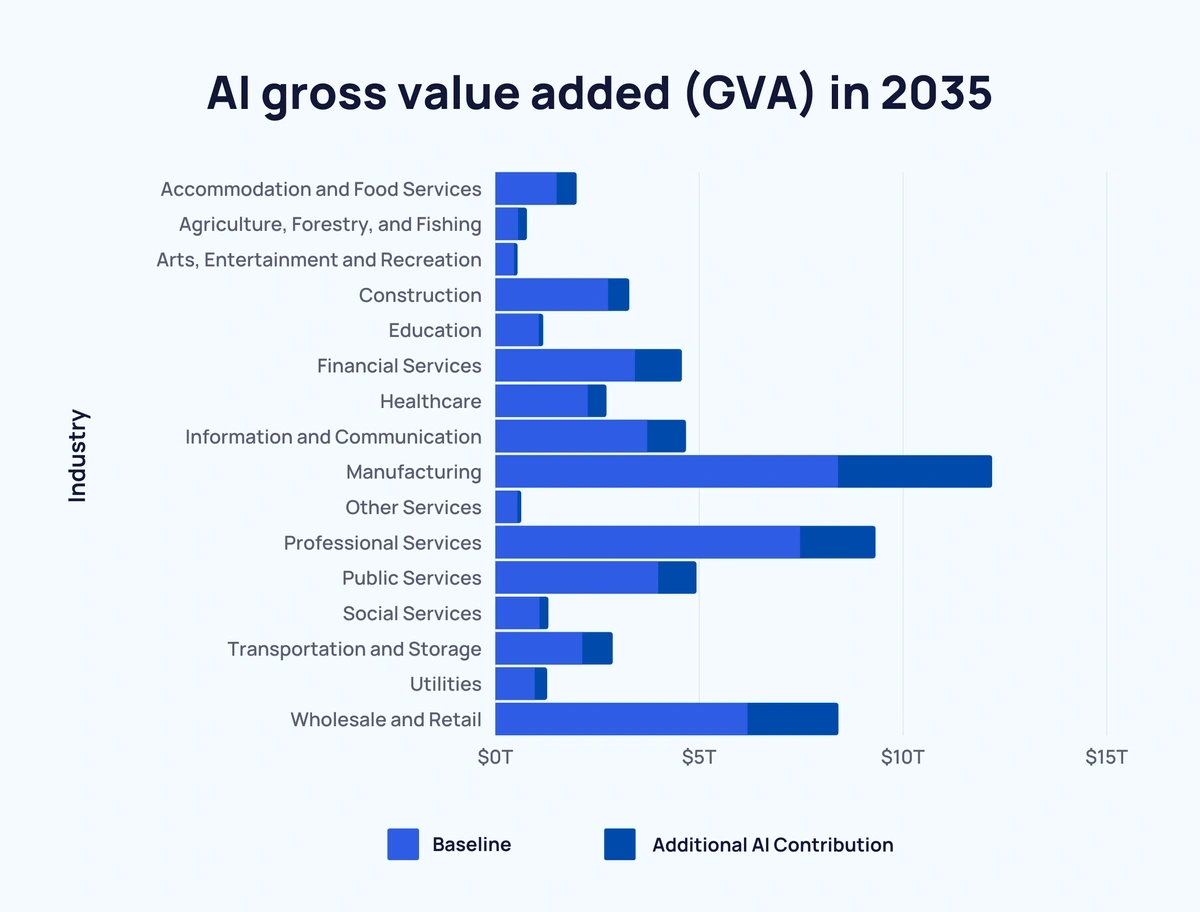
The AI industry has a foothold in various business functions, from cloud computing for datasets to streamlining company decision-making.
Industry verticals utilizing AI technology include tech-related sales, insurance, banking, telecom, healthcare, manufacturing, retail, and marketing, to name a few.
| Industry | Baseline | Additional AI Contribution |
| Accommodation and Food Services |
$1.5 trillion |
$489 billion |
| Agriculture, Forestry, and Fishing |
$554 billion |
$215 billion |
| Arts, Entertainment, and Recreation |
$453 billion |
$87 billion |
| Construction |
$2.76 trillion |
$520 billion |
| Education |
$1.06 trillion |
$109 billion |
| Financial Services |
$3.42 trillion |
$1.15 trillion |
| Healthcare |
$2.26 trillion |
$461 billion |
| Information and Communication |
$3.72 trillion |
$951 billion |
| Manufacturing |
$8.4 trillion |
$3.78 trillion |
| Other Services |
$535 billion |
$95 billion |
| Professional Services |
$7.47 trillion |
$1.85 trillion |
| Public Services |
$3.99 trillion |
$939 billion |
| Social Services |
$1.08 trillion |
$216 billion |
| Transportation and Storage |
$2.13 trillion |
$744 billion |
| Utilities |
$962 billion |
$304 billion |
| Wholesale and Retail |
$6.18 trillion |
$2.23 trillion |
Autonomous vehicles could generate between $300 billion and $400 billion in global revenue (McKinsey)
The self-driving car market is proving to be more than a novelty niche, potentially grossing $400 billion by 2035.
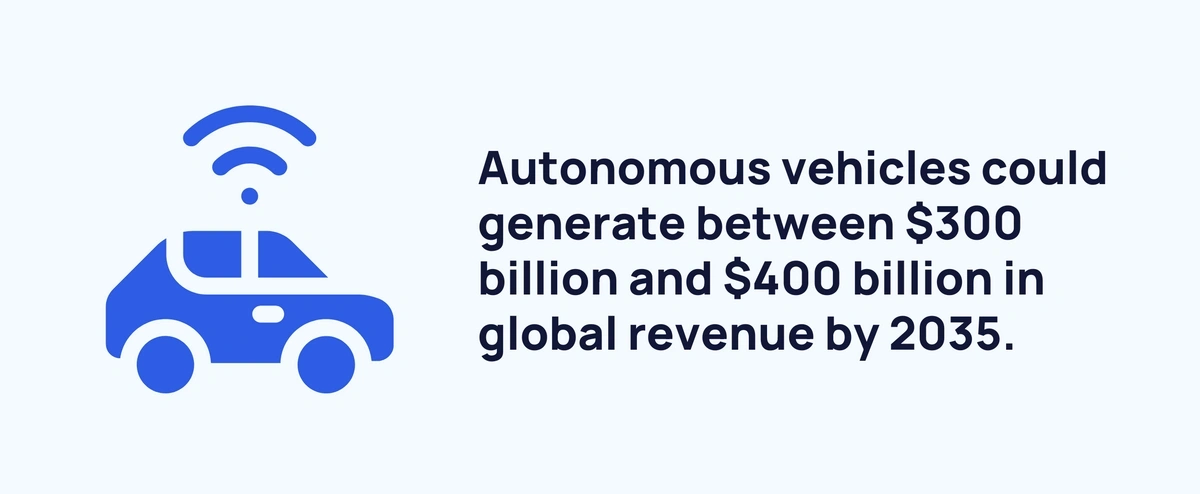
Just 7% of people trust chatbots when making a claim (Accenture)
The prevalence of chatbots may be increasing, but they still have a long way to go.
Just under 1 in 10 people (7%) trust chatbots when making a claim.
A stark difference from the 49% that trust human advisors.
AI tech is expected to increase banking industry revenue by $1 billion between 2023 and 2026 (Accenture)
By next year, AI technology will have added $1 billion to the banking industry.
Around 2 in 5 medical professionals now use computer systems to aid diagnosis (Gartner)
38% of medical providers use computer systems as their diagnosis assistants.
AI is helping manufacturing companies outperform competitors (Microsoft)
Manufacturing businesses that utilize AI are performing 12% better than businesses that continue to use traditional methods only.
19 in every 20 customer interactions will be AI-assisted as of 2025 (AI Business)
In the next few years, the retail industry will be able to relinquish much of its communication to AI.
In fact, it predicted that over 95% of online and telephone communications will utilize AI technology as of this year.
AI in Marketing, Customer Service, and Sales Statistics
Marketing and sales departments prioritize AI and ML for market revenue success 40% more than other industry departments (Forbes)
AI marketing companies, customer service roles, and sales departments rely on process automation to increase their market revenue share.
Artificial intelligence is a solution for overworked customer-facing roles.
AI algorithms increase leads by as much as 50% (Harvard Business Review)
AI algorithms reveal data on which products generate the highest profit margins and offer valuable insight into a client’s purchasing habits.
Recent data shows that using AI for sales:
- Increases leads by 50%
- Reduces call times by 60%
- Results in overall cost reductions of up to 60%
Around 4 in 10 marketers believe that AI email marketing improves market revenue (Statista)
In total, 41.29% of marketers agree that using AI for email marketing generates higher market revenue.
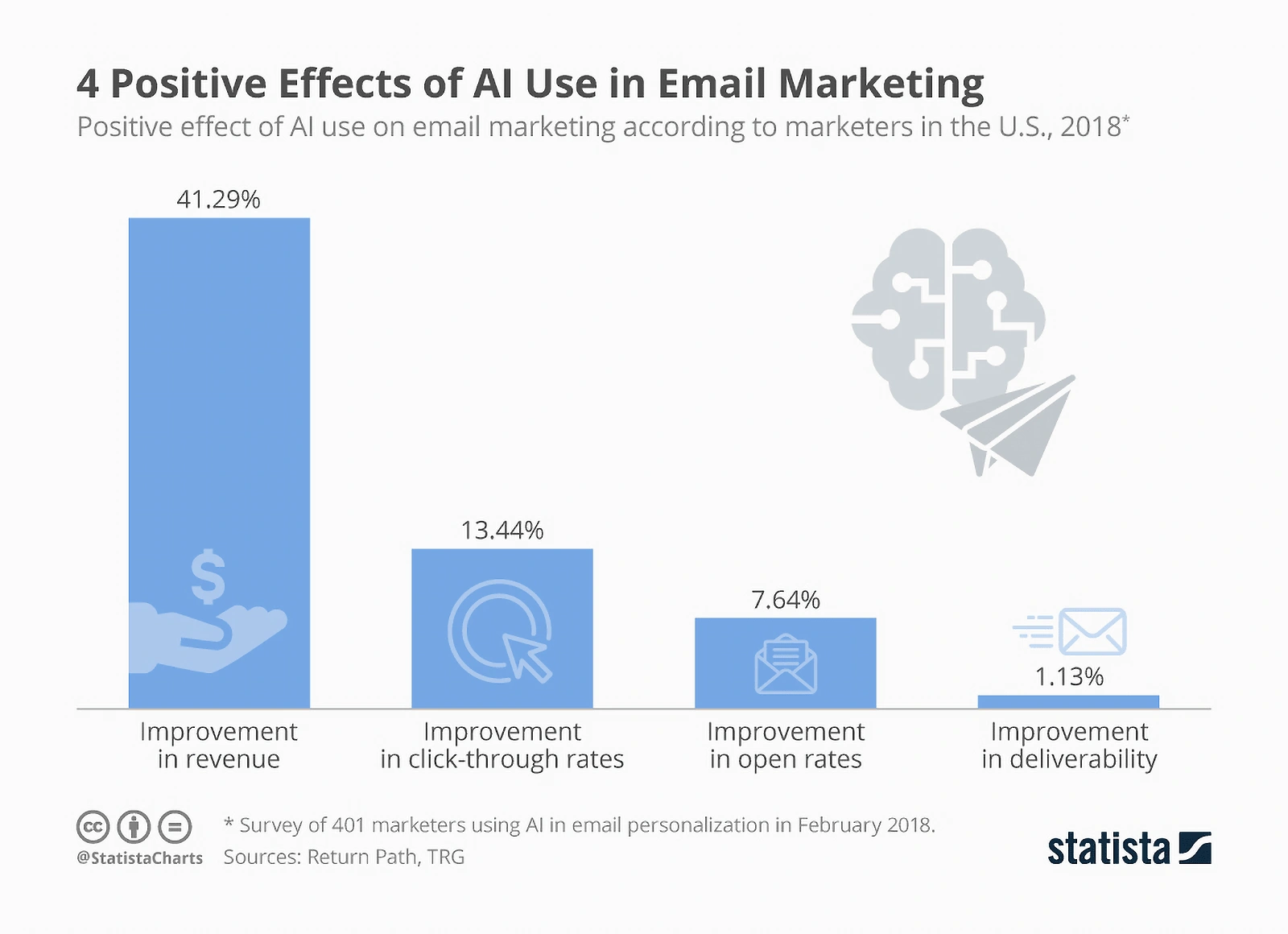
AI Replacing Jobs and Employment Statistics
Transportation and storage workers face the greatest risk of job automation (PwC)
Many people worry that AI will continue to take jobs from human workers, resulting in a job crisis.
And some are even asking whether they should start looking for a new career solution before automation makes their current role obsolete.
Want to Spy on Your Competition?
Explore competitors’ website traffic stats, discover growth points, and expand your market share.
Below is data on employment shares and the proportion of jobs at high risk of automation by the early 2030s for all UK industry sectors:
| Industry | Share of Employment | Risk of Job Automation |
| Wholesale and retail trade | 14.80% | 44% |
| Manufacturing | 7.60% | 46.4% |
| Administrative and support services | 8.40% | 37.4% |
| Transportation and storage | 4.90% | 56.4% |
| Professional, scientific, and technical | 8.80% | 25.6% |
| Human health and social work | 12.40% | 17% |
| Accommodation and food services | 6.70% | 25.5% |
| Construction | 6.40% | 23.7% |
| Public administration and defense | 4.30% | 32.1% |
| Information and communication | 4.10% | 27.3% |
| Financial and insurance | 3.20% | 32.2% |
| Education | 8.70% | 8.5% |
| Arts and entertainment | 2.90% | 22.3% |
| Other services | 2.70% | 18.6% |
| Real estate | 1.70% | 28.2% |
| Water, sewage, and waste management | 0.60% | 62.6% |
| Agriculture, forestry, and fishing | 1.10% | 18.7% |
| Electricity and gas supply | 0.40% | 31.8% |
| Mining and quarrying | 0.20% | 23.1% |
| Domestic personnel and self-subsistence | 0.30% | 8.1% |
| Total/Average for all sectors | 100% | 30% |
Fears of being made redundant might be justified for workers in the transportation and storage (56.4%), manufacturing (46.4%), and wholesale & retail (44%) industries in the UK.
Across all US industries, AI and ML are expected to replace 16% of all US jobs in less than half a decade (Forrester)
Despite this, new jobs are likely to arise. The AI market will create 9% of new jobs in the US for a net loss of 7%.
Where Is AI Used Today?
The uses for AI stretch far beyond cataloging the content of your online shopping cart.
Artificial intelligence systems can function as digital personal assistants, turn the lights on in a smart home, and even protect against infectious diseases like COVID-19.
Over 1 in 5 US adults own a smart speaker (Statista)
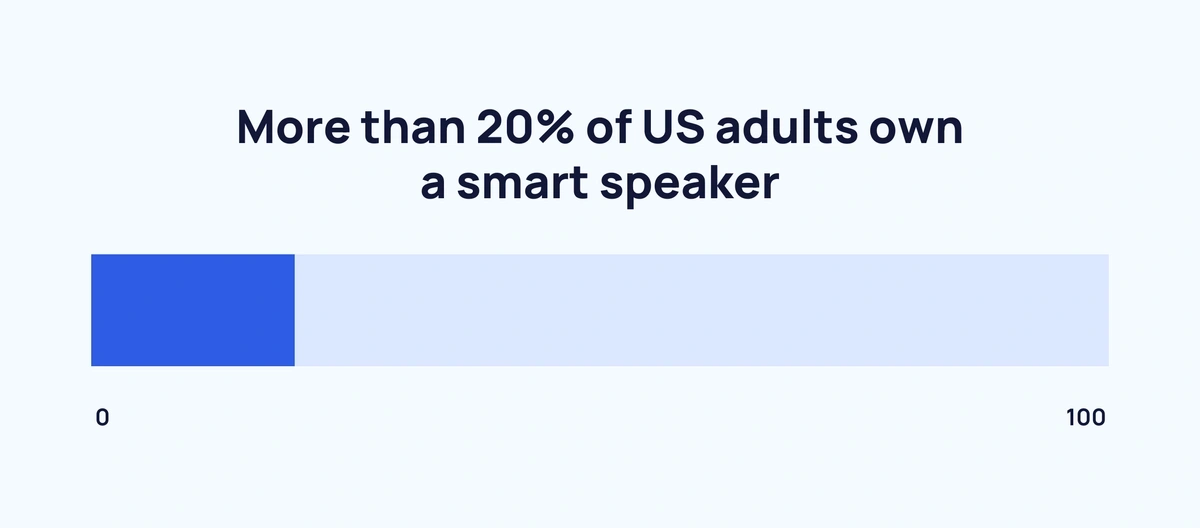
Popular smart speakers include Apple’s HomePod and the Amazon Echo.
These use speech recognition technology to provide weather forecasts, play music, or make emergency phone calls.
AI is used in disease prevention to discover previously unknown strains (OECD)
Before COVID-19 became an all-too-common term in the healthcare sector, AI reports included an outbreak of an unknown type of pneumonia.
Some smartwatches utilize AI to time hand-washing sessions for maximum cleanliness (Apple)
Wearable tech can even aid the healthcare sector’s mission to create a healthier world.
Popular AI Function Statistics
It is estimated that there are over 8 billion voice assistants currently in use (BusinessWire)
Chatbots may still need improvements in natural language processing before consumers are on board.
But voice assistants are a prime example of AI merging seamlessly with everyday life.
Here is the number of digital voice assistants in use worldwide from 2019 to 2024:
| Year | Number of Digital Voice Assistants |
| 2019 | 3.25 billion |
| 2020* | 4.2 billion |
| 2024* | 8.4 billion |
*Projected figures.
More than half of Americans use voice assistants for information purposes (Edison Research)
Over 110 million virtual assistant users reside in the US.
As of early 2020, voice assistants were a source of information for 51% of all US residents.
By the end of this year, the NLP market share is forecast to increase to over $43 billion (Tractica)
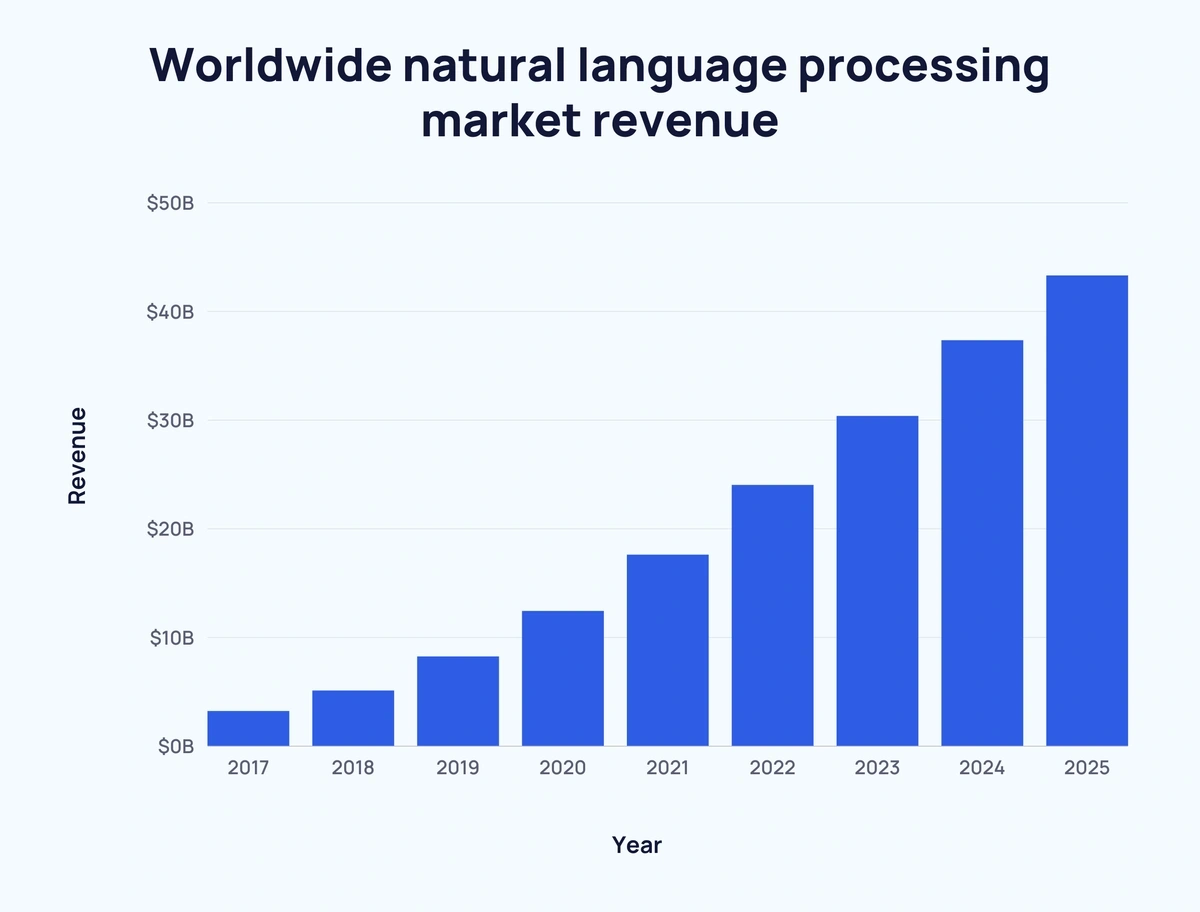
Natural language processing (NLP) helps computers translate human language into information they understand by manipulating data.
Companies are striving to bridge the gap between human language and machine intelligence.
Here’s a look at global revenue from the NLP market from 2017 to 2025:
| Year |
Revenue |
| 2017 |
$3.18 billion |
| 2018 |
$5.07 billion |
| 2019* |
$8.21 billion |
| 2020* |
$12.4 billion |
| 2021* |
$17.58 billion |
| 2022* |
$24 billion |
| 2023* |
$30.35 billion |
| 2024* |
$37.33 billion |
| 2025* |
$43.29 billion |
*Projected figures
During the forecast period of 2017-2025, the NLP market is set to grow by around 14x.
Over the next few years, it will become more common for patients to download and share their medical data (Markets and Markets)
The healthcare sector should expect a higher usage of cloud resources, such as ML, natural language processing, and deep learning.
As of 2021, 57% of businesses using AI/ML used the technology to improve customer experience (Algorithmia)

Algorithms and ML enable computers to predict patterns, evaluate accuracy, and continually optimize the process.
A computer’s speech recognition capability and a smartphone’s ability to geotag video content before sharing are examples of ML.
| Use case |
2020 |
2021 |
Change |
| Generating customer insights/intelligence |
37% |
50% |
↑ 13% |
| Improving customer experience |
34% |
57% |
↑ 23% |
| Retaining customers |
29% |
31% |
↑ 2% |
| Interacting with customers |
28% |
48% |
↑ 20% |
| Recommender systems |
27% |
27% |
– 0% |
| Detecting fraud |
27% |
46% |
↑ 19% |
| Reducing customer churn |
26% |
22% |
↓ 4% |
| Acquiring new customers |
26% |
34% |
↑ 8% |
| Increasing customer loyalty |
20% |
40% |
↑ 20% |
| Increasing long-term customer engagement |
19% |
44% |
↑ 25% |
| Building brand awareness |
14% |
31% |
↑ 17% |
| Other |
15% |
1% |
↓ 14% |
Google’s deep ML technology is claimed to be 99% accurate (Google AI Blog)
It is also shown to be more effective than human pathologists at detecting metastatic breast cancer.
ML allows Oxford University’s AI system to read lips at a 93% accuracy level (BBC)
This makes the system more accurate than human lip readers.
Google uses global AI technologies to process 6.9 billion daily search queries (techjury)
AI technology makes searching and organizing big data sets possible.
When conventional methods of storing and collecting big data fail, AI technology takes the reins and processes the billions of search queries search engines receive daily.
AI Challenges & Predictions
Job loss is a primary concern for AI skeptics (Tractica)
AI progress comes with its fair share of ethical, business, and practical concerns.
These include job loss and the ethical implications of computer integration with conscious thought.
Elon Musk warns that AI services could overtake humans in 2025 (Independent)
Elon Musk is best known for electric cars and rocket ships. But he’s also an investor in one of the world’s fastest-growing AI startups: OpenAI. This makes it noteworthy that Musk wonders whether AI will be sentient in the coming years.
Only 8.5% of people believe they can “always trust” AI Overviews when searching online (Exploding Topics)
Original research from Exploding Topics found significant skepticism surrounding Google’s Ai Overviews feature. Despite that, only 8% of people always follow links to the source material.
Around 3 in 4 CEOs worry about limited transparency in the AI market (PwC)

A 2017 survey found that 76% of CEOs worry about the lack of transparency and the potential for skewed biases in the global AI market.
4 in 10 executives believe AI is prohibitively expensive (Harvard Business Review)
However, 40% of executives agree that advanced AI technologies and the experts who run them are currently too expensive to implement.
Key Takeaways
The AI market clearly has a promising and profitable future.
While concerns over job loss exist, there is data to indicate that the technology will create more startups and jobs than it destroys.
One way or another, AI is most definitely part of the present. And the future.
For more related content, check out Top AI and Machine Learning Trends and Trending Machine Learning Startups.
AI Research
YouTube Unveils AI-Powered Tools for Creators

An artificial intelligence (AI)-powered “creative partner” for creators is one of several AI tools unveiled Tuesday (Sept. 16) by YouTube.
AI Research
AI in PR Research: Speed That Lacks Credibility

Artificial intelligence is transforming how research is created and used in PR and thought leadership. Surveys that once took weeks to design and analyze can now be drafted, fielded and summarized in days or even hours. For communications professionals, the appeal is obvious: AI makes it possible to generate insights that keep pace with the news cycle. But does the quality of those insights hold?
In the race to move faster, an uncomfortable truth is emerging. AI may make aspects of research easier, but it also creates enormous pitfalls for the layperson. Journalists rightfully expect research to be transparent, verifiable and meaningful. This credibility cannot be compromised. Yet an overreliance on AI risks jeopardizing the very characteristics that make research such a powerful tool for thought leadership and PR.
This is where the opportunity and the risk converge. AI can help research live up to its potential as a driver of media coverage, but only if it is deployed responsibly, and never as a total substitute for skilled practitioners. Used without oversight, or by untrained but well-meaning communicators, it produces data that looks impressive on the surface but fails under scrutiny. Used wisely, it can augment and enhance the research process but never supplant it.
The Temptation: Faster, Cheaper, Scalable
AI has upended the traditional pace of research. Writing questions, cleaning data, coding open-ended responses and building reports required days of manual effort. Now, many of these tasks can be automated.
- Drafting: Generative models can create survey questions in seconds, offering PR teams a head start on design.
- Fielding: AI can help identify fraudulent or bot-like responses.
- Analysis: Large datasets can be summarized almost instantly, and open-text responses can be categorized without armies of coders.
- Reporting: Tools can generate data summaries and visualizations that make insights more accessible.
The acceleration is appealing. PR professionals can, in theory, generate surveys and insert data into the media conversation before a trend peaks. The opportunity is real, but it comes with a condition: speed matters only when the research holds up to scrutiny.
The Risk: Data That Doesn’t Stand Up
AI makes it possible to create research faster, but not necessarily better. Fully automated workflows often miss the standards required for earned media.
Consider synthetic respondents, artificial personas generated by AI to simulate human answers to surveys, trained on data from previous surveys. On the surface, they provide instant answers to survey questions. But research shows they diverge from real human data once tested across different groups and contexts. The issue isn’t limited to surveys. Even at the model level, AI outputs remain unreliable. OpenAI’s own system card shows that despite improvements in its newest model, GPT-5 still makes incorrect claims nearly 10% of the time.
For journalists, these shortcomings are disqualifying. Reporters and editors want to know how respondents were sourced, how questions were framed and whether findings were verified. If the answer is simply “AI produced it,” credibility collapses. Worse, errors that slip into coverage can damage brand reputation. Research meant to support PR should build trust, not risk it.
Why Journalists Demand More, Not Less
The reality for PR teams is that reporters are inundated with pitches. That volume has made editors more discerning, and credible data can differentiate a pitch from the competition.
Research that earns coverage typically delivers three things:
- Clarity: Methods are clearly explained.
- Context: Results are tied to trends or issues audiences care about.
- Credibility: Findings are grounded in sound design and transparent analysis.
These expectations have only intensified. Public trust in media is at a historic low. Only 31% of Americans trust the news “a great deal” or “a fair amount.” At the same time, 36% have “no trust at all,” the highest level of complete distrust Gallup has recorded in more than 50 years of tracking. Reporters know this and apply greater scrutiny before publishing any research.
For PR professionals, the implication is clear: AI can speed up processes, but unless findings meet editorial standards, they will never see the light of day.
Why Human Oversight Is Indispensable
AI can process data at scale, but it cannot replicate the judgment or accountability of human researchers. Oversight matters most in four areas:
- Defining objectives: Humans decide which questions are newsworthy or align with campaign goals and what narratives are worth testing.
- Interpreting nuance: Machines can classify sentiment, but are bad at identifying sarcasm, cultural context and emotional cues that shape meaningful insights.
- Accountability: When findings are published, people – not algorithms – must explain the methods and defend the results.
- Bias detection: AI reflects the limitations of its training data. Without human review, skewed or incomplete findings can pass as fact.
Public opinion reinforces the need for this oversight. Nearly half of Americans say AI will have a negative impact on the news they get, while only one in 10 say it will have a positive effect. If audiences are skeptical of AI-created news, journalists will be even more cautious about publishing research that lacks human validation. For PR teams, that means credibility comes from oversight: AI may accelerate the process, but only people can provide the transparency that makes research media ready.
AI as a Partner, Not a Shortcut
AI is best used strategically. It is as an “assistant” that enhances workflows rather than a substitute for expertise. That means:
- Letting AI handle repetitive tasks such as transcription, always with human oversight.
- Documenting when and how AI tools are used, to build transparency.
- Validating AI outputs against human coders or traditional benchmarks.
- Training teams to understand AI’s capabilities and limitations.
- Aligning with evolving disclosure standards, such as the AAPOR Transparency Initiative.
Used this way, AI accelerates processes while preserving the qualities that make research credible. It becomes a force multiplier for human expertise, not a replacement for it.
What’s at Stake for PR Campaigns
Research has always been one of the most powerful tools for earning media. A well-executed survey can create headlines, drive thought leadership and support campaigns long after launch. But research that lacks credibility can do the opposite, damaging relationships with journalists and eroding trust.
Editors are paying closer attention to how AI is being used in PR. Some are experimenting with it themselves, while exercising caution. In Cision’s 2025 State of the Media Report, nearly three-quarters of journalists (72%) said factual errors are their biggest concern with AI-generated material, while many also worried about quality and authenticity. And although some reporters remain open to AI-assisted content if it is carefully validated, more than a quarter (27%) are strongly opposed to AI-generated press content of any kind. Those figures show why credibility cannot be an afterthought: skepticism is high, and mistakes will close doors.
The winners will be teams that integrate AI responsibly, using it to move quickly without cutting corners. They will produce findings that are timely enough to tap into news cycles and rigorous enough to withstand scrutiny. In a crowded media landscape, that balance will be the difference between earning coverage and being ignored.
Conclusion: Credibility as Currency
AI is here to stay in PR research. Its role will only expand, reshaping workflows and expectations across the industry. The question is not whether to use AI, but how to use it responsibly.
Teams that treat AI as a shortcut will see their research dismissed by the media. Teams that treat it as a partner – accelerating processes while upholding standards of rigor and transparency – will produce insights that both journalists and audiences trust.
In today’s environment, credibility is the most valuable currency. Journalists will continue to demand research that meets high standards. AI can help meet those standards, but only when guided by human judgment. The future belongs to PR professionals who prove that speed and credibility are not in conflict, but in partnership.
AI Research
High Schoolers, Industry Partners, and Howard Students Open the Door to Tech at the Robotics and AI Outreach Event

Last week in Blackburn Center, Howard University welcomed middle school, high school, and college students to explore the rapidly expanding world of robotics over the course of its second Robotics and AI Outreach Event. Teams of high school students showcased robots they built, while representatives from partnering Amazon Fulfillment Technologies, FIRST Robotics, the U.S. Navy and U.S. Army Research Laboratories, and Viriginia Tech gave presentations on their latest technologies, as well as ways to get involved in high-tech research.
Across Thursday and Friday, Howard students and middle and high schoolers from across the DMV region heard from university researchers creating stories with generative AI and learned how they can get involved in STEM outreach from the Howard University Robotics Organization (HURO) and FIRST Robotics. They also viewed demonstrations of military unmanned ground vehicles and the Amazon Astro household robot. The biggest draw, however, was the robotics showcase in the East Ballroom.
Over both days, middle and high school teams from across the DMV presented their robots as part of the FIRST Tech Challenge (FTC) and FIRST Robotics Competition, during which they were tasked with designing a robot within six weeks. The program is intensive and gives students a taste of a real-world engineering career, as the students not only design and build their entries, but also engage in outreach events and raise their own funding each year.
“It’s incredible,” said Shelley Stoddard, vice president of FIRST Chesapeake. “I liken our teams to entrepreneurial startups. Each year they need to think about who they’re recruiting, how they’re recruiting; what they’re going to do for fundraising. If they want to have a brand, they create that, they manage that. We are highly encouraging of outreach because we don’t want it to be insular to just their schools or their classrooms.”
Reaching the Next Generation of Engineers
This entrepreneurial spirit carries across the teams, such as the Ashburn, Virginia-based BeaverBots, who showed up in matching professional attire to stand out to potential recruits and investors as they presented three separate robots they’ve designed over the years — the Stubby V2, Dam Driver V1, and DemoBot — all built for lifting objects. Beyond already being skilled engineers and coders in their own right, the team has a heavy focus on getting younger children into robotics, even organizing their own events.
“One of the biggest things about our outreach is showing up to scrimmages and showing people we actually care about robotics and want to help kids join robotics,” said team member and high school junior Savni (last name withheld). “So, for example we’ve started a team in California, we’ve mentored [in] First Lego League, and we’ve hosted multiple scrimmages with FTC teams.”
“We also did a presentation in our local Troop 58 in Ashburn, where we showed our robot and told kids how they can get involved with FIRST,” added team vice-captain Aryan. “Along with that, a major part of our fundraising is sponsorship and matching grants. We’ve received matching grants from CVS, FabWorks, and ICF.”
This desire to pay it forward and get more people involved in engineering wasn’t limited to the teams. Members of the student-run HURO were also present, putting on a drone demo and giving lectures advocating for more young Black intellectuals to get into science and engineering.
“Right now, we’re doing a demo of one of our drones from the drone academy,” explained senior electrical engineering major David Toler II. “It’s a program we’ve put on since 2024 as a way to enrich the community around us and educate the Black community in STEM. We not only provide free drones to high schools, but we also work hands-on with them in very one-on-one mentor styles to give them knowledge to build on themselves and understand exactly how it works, why it works, and what components are necessary.”
Building A Strong Support Network
HURO has been involved with the event from the beginning. Event organizer and Howard professor Harry Keeling, Ph.D., credits the drone program for helping the university’s AI and robotics outreach take flight.
“It started with the drone academy, then that expanded through Dr. Todd Shurn’s work through the Sloan Foundation in the area of gaming,” explained Keeling. “Then gaming brought us to AI, and we got more money from Amazon and finally said ‘we need to do more outreach.’”
Since 2024, Keeling has been working to bring more young people into engineering and AI research, relying on HURO, other local universities and high schools, industry partners like Amazon, and the Department of Defense, to build a strong network dedicated to local STEM outreach. Like with FIRST Robotics, a large part of his motivation with these growing partnerships is to prepare students for successful jobs in the industry.
“We tell our students that in this field, networking is how you accomplish career growth,” he said. “None of us knows everything about what we do, but we can have a network where we can reach out to people who know more than we do. And the stronger our network is, the more we are able to solve problems in our own personal and professional lives.”
At next year’s event, Keeling plans to step back and allow HURO to take over more of the organizing and outreach, further bringing the next generation into leadership positions within the field. Meanwhile, he is working with other faculty members across the university to bring AI to the curriculum, further demystifying the technology and ensuring Howard students are prepared for the future.
For Keeling, outreach events like this are vital to ensuring that young people feel confident in entering robotics, rather than intimidated.
“One thing I realized is young people gravitate to what they see,” he said. “If they can’t see it, they can’t conceive it. These high schoolers[and] middle schoolers are getting a chance to rub elbows with a lot of professionals [and] understand what a roboticist ultimately might be doing in life.”
He hopes that his work eventually makes children see a future in tech as just as possible as any other field they see on TV.
“I was talking with my daughters, and I asked them at dinner ‘what do you want to be when you grow up?’” Keeling said. “And my youngest one said astronauts, and an artist, and a cook. Now hopefully one day, one of those 275 students that were listening to my presentation will answer the question with ‘I want to be an AI expert. I want to be a roboticist.’ Because they’ve come here, they’ve seen and heard what they can do.”
-

 Business3 weeks ago
Business3 weeks agoThe Guardian view on Trump and the Fed: independence is no substitute for accountability | Editorial
-
Tools & Platforms1 month ago
Building Trust in Military AI Starts with Opening the Black Box – War on the Rocks
-

 Ethics & Policy2 months ago
Ethics & Policy2 months agoSDAIA Supports Saudi Arabia’s Leadership in Shaping Global AI Ethics, Policy, and Research – وكالة الأنباء السعودية
-

 Events & Conferences4 months ago
Events & Conferences4 months agoJourney to 1000 models: Scaling Instagram’s recommendation system
-

 Jobs & Careers3 months ago
Jobs & Careers3 months agoMumbai-based Perplexity Alternative Has 60k+ Users Without Funding
-

 Podcasts & Talks2 months ago
Podcasts & Talks2 months agoHappy 4th of July! 🎆 Made with Veo 3 in Gemini
-

 Education3 months ago
Education3 months agoVEX Robotics launches AI-powered classroom robotics system
-

 Education2 months ago
Education2 months agoMacron says UK and France have duty to tackle illegal migration ‘with humanity, solidarity and firmness’ – UK politics live | Politics
-

 Podcasts & Talks2 months ago
Podcasts & Talks2 months agoOpenAI 🤝 @teamganassi
-

 Funding & Business3 months ago
Funding & Business3 months agoKayak and Expedia race to build AI travel agents that turn social posts into itineraries

